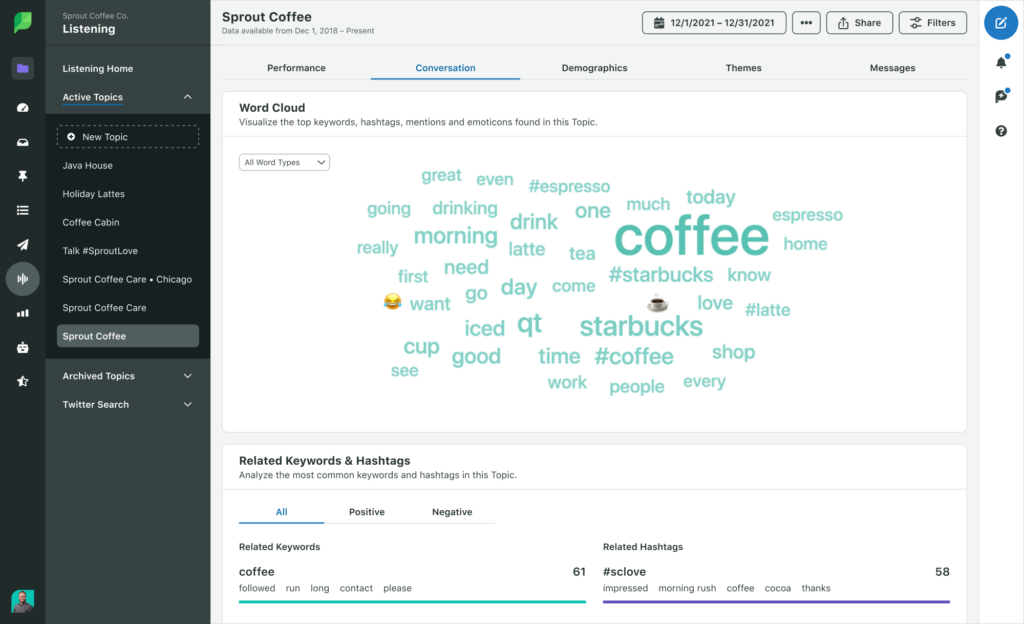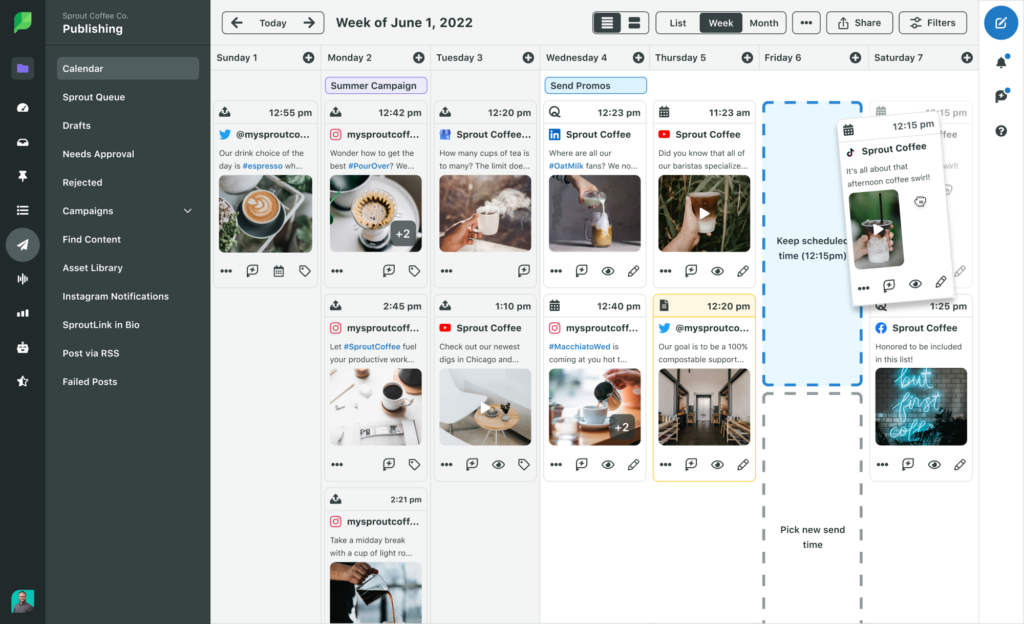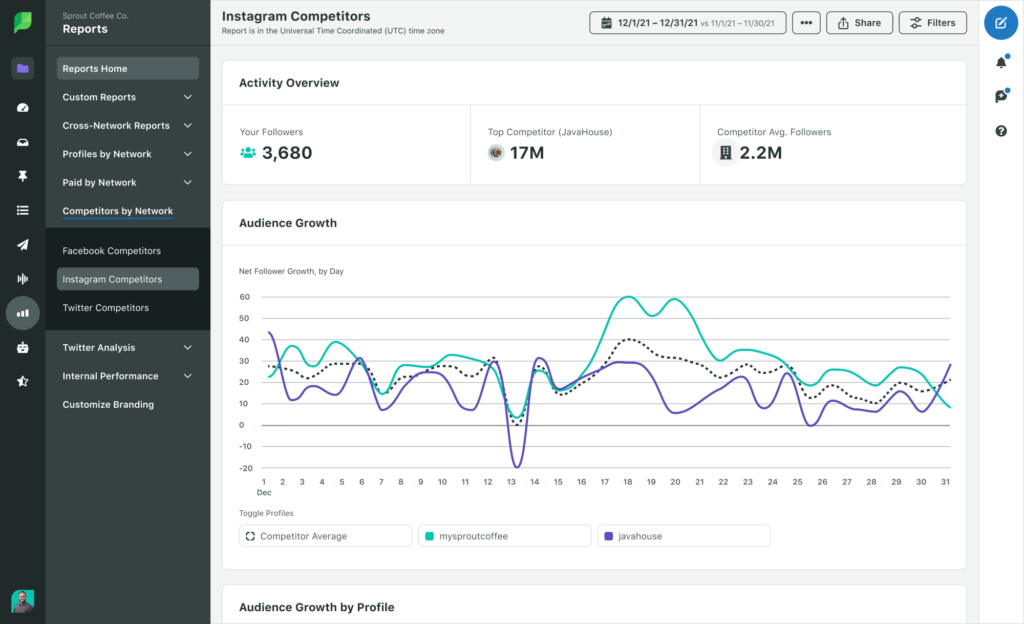How to craft an effective social media content strategy
Written by Sarah Aboulhosn
Published on May 2, 2023
Reading time 10 minutes

The content you post on social media can turn your brand into a household name and your followers into fans. This kind of impact only comes from having a solid social media content strategy.
The best way to stand out on social media is to identify specific goals, create valuable posts that align with them and distribute the right content on the right platforms.
There isn’t one cookie-cutter social media strategy that will guarantee success. Your strategy will differ depending on your industry, audience and performance over time. There are, however, specific ways to build a long-term plan that grows your brand and business.
In this article, you’ll learn how to create a content strategy for social media. Feel free to jump ahead with this list:
- Identify and set goals
- Research your audience
- Analyze your competitors
- Audit your current social content
- Choose your content types
- Build a content calendar
- Promote and distribute your content
- Measure results
- Free social media content strategy templates
- Putting it all together: craft your social media content plan
1. Identify and set goals
The first step toward a long-term social media strategy is to set your content goals. Having goals in mind will help you start planning out the type of content to create.

(Source)
This process involves digging deep into your brand values as well as researching your audience.
Start by getting clear on your overall marketing goals and how you want your social media content strategy to serve them. The more specific your marketing goals are, the better you will be able to tailor your social media content to meet them.
For example, if your main marketing goal is to convert more sales from social media, then your strategy should incorporate publishing and promoting posts that move people to a landing page or another part of your social media marketing funnel—like including a link CTA in your content.
2. Research your audience
You can’t create great social content without knowing who it’s for. Having buyer personas for social—or fictional representations of your ideal customers—will help guide your social media content plan.
Start by using your data to surface basic demographic information like age and location. Then take this further by gathering insights about how your ideal customers talk about your brand, industry and products—this will help you paint a clearer picture of who they are, what they care about and what kind of content they might want to see from you.
Sprout’s social listening solution helps you take this further by surfacing brand keywords and conversations—even when you’re not tagged—that can reveal pain points and opportunities for your content to fill.

Additionally, talk to your customer care team to hone in on your audience’s common FAQs, what they love and what frustrates them.
3. Analyze your social media competitors
To understand how your social media content strategy is performing, you need to look beyond your own data. A competitive analysis will help spark ideas for your content (i.e. what are they doing that you can do better? What formats do they use?) and create better benchmarks and goals for your strategy.
The right tool will make pulling insights from your competitors (for example: average engagements, growth rate and top content) at scale easy by automating the process. All of which helps you shape data-driven goals and strategies to make better content.
4. Audit your current social content
Once clear on your audience and goals, it’s time to conduct a social media content audit on what you’ve created so far.
A content audit is one of the best ways to know how to create a content strategy for social media that fits your brand. This will help you substantiate what you think is working well with quantitative data that shows you how each post performs.
Look at which posts performed well, which ones didn’t and what you posted on each platform. What you look for in the audit should align directly with your content goals. For example, if one of your goals is to improve brand awareness, look at your follower count and impressions or reach on each platform, and identify which posts resulted in new followers.
If you’re using a social media management platform like Sprout Social, you can look at all of your social media data and analytics in one place. Use Sprout’s Report Builder for a holistic view of how all of your posts are performing.

Even without a social media tool, you can analyze your data by exporting each platform’s analytics into a spreadsheet. Facebook, Twitter, Pinterest Business and LinkedIn Business accounts let you easily export your post and page analytics directly from the platform.
You might notice a disconnect between posts you think should do well and the actual top performers. In this case, look closely at the language and tone you’re using on the underperforming content. You may have strayed away from your brand’s authentic voice. Your followers may interpret those posts as inauthentic or irrelevant, causing a decrease in engagement. Or, there may be new or trending content formats that your audience prefers. According to The 2022 Sprout Social Index™, 66% of consumers think short-form video is the most engaging in-feed content. Are you keeping up with what your audience likes?

Some posts serve to help you meet bigger marketing goals. But even promotional content should be on brand and true to your voice. Remember: Your audience began following you for a reason. Stick with your unique voice and style as much as possible and create content that authentically markets your brand. For example, the Oklahoma Department of Wildlife Conservation has a witty, comedic voice on Twitter—a voice that not all similar organizations share.
 If you’re not sure what your brand voice is, take our quiz to start fine-tuning your brand’s social persona.
If you’re not sure what your brand voice is, take our quiz to start fine-tuning your brand’s social persona.
While you’re doing research, also take note of which platforms your content succeeds most on. You might want to target every social platform but it’s unrealistic to expect to perform well on all of them. You want to allocate your resources to the platforms that serve your brand and your audience the most.
5. Choose your content types
This is where you can have fun with data-driven creativity. We already mentioned that short-form video is extremely popular—but when crafting your social media content plan, think back to the social buyer personas you set up, and think about what formats they’re likely consuming.
Change up the types of content you’re publishing, as well. According to the Sprout Social Index™ 2022, consumers like to see brands they follow highlighting their product, service or personality, or posting demos and customer testimonials.

Repetitive or overly promotional posts may turn fans away. So change up your content. Here are a few ideas:
- Feature how-tos or edu-tainment videos featuring your products
- Leverage user-generated content
- Partner with creators
- Jump on trends (as long as they fit your brand)
- Feature employees or office tours for authentic, less produced video
- Host contests
- Go behind-the-scenes
- Go live to engage your audience in real time
- Create polls or quizzes in posts or stories
- Ephemeral content
The best way to know what content types and formats will work for you is to dig into your data. Looking at your most successful posts will help you decide what to create. For example, Sprout’s Post Performance Report enables you to analyze your most successful posts across all of your channels, sorted by your top metrics.

6. Build a content calendar
Once you know what performs best and you’ve identified your primary goals, it’s time to build a social media content calendar. A calendar will let you take a big-picture approach to your social media content plan. It will help you visualize your ideas and organize them, making your strategy easier to execute. Your content calendar will be a hub for everything you post.

When planning content, don’t be afraid to repurpose content and schedule it across different platforms to get the most out of it. When deciding where to post what content, also consider what performs well on that platform based on your audit.
Keep in mind that there are best practices when it comes to the best times to post on each platform. If you want to make finding the right posting times easier, Sprout’s ViralPost® feature collects data from your followers and puts together reports that tell you when you post to achieve the most reach.

Your strategy will involve the collective knowledge of a lot of different people within your organization. A content calendar makes it easier to collaborate on social media posts with different people across your company. This also aids in cross-team collaboration to create a more well-rounded plan.

7. Promote and distribute your content
Your social media strategy goes beyond what you post on your social channels. A good strategy involves finding ways to actively distribute your content to maximize brand awareness. Here are a few ways to plan your distribution:
Schedule your content ahead of time
Social media tools, like Sprout’s scheduling and publishing features, make content distribution a no-brainer—especially if you post multiple times a day, like Netflix does on Twitter. Plus, this helps you post at the right time.
Recognizing when your audience is active and sharing posts at the right time will help you reach more people. If you’re only posting on social media the minute content goes live, you’re missing out on a massive opportunity for optimizing your reach.
Encourage others to share your posts
Other people sharing your content is excellent social proof as well. Your social media content strategy should include responding to or reposting people who share your content. Encourage your audience to engage with your content by asking a question and encouraging them to share their answers, on social media or in the comments section of a blog post.
And leverage your company’s employees to spread the word, as well. An employee advocacy strategy can drastically increase the reach of your company’s content. Employees are, in a way, “influencers” for your brand. A tool like Sprout’s Advocacy platform enables you to scale your program, and integrates your advocacy workflow into your social workflow seamlessly.
Use platform-specific features
Individual social media platforms have ways to help you maximize reach, as well. On platforms like Twitter and Instagram, utilizing hashtags is a great way to distribute your content further. Hashtags help you reach people who not only follow you but are following a specific trend or interest. On LinkedIn and Facebook, join groups related to your industry and share content when it relates to the conversation.
Collaborate with creators
Another good distribution strategy involves networking with bloggers and content creators in your niche. Other brands are more likely to share your content with their audience if you have a relationship and will return the favor. Just remember that anything you share with your audience should still be valuable to them and relate to your brand.
@sproutsocial How to become a content creator with tips from @J A Y D E. ✨ creator creatorrevolution creatoreconomy socialmediamarketing socialmediamanager socialmediatips
8. Measure results
The last step to an effective social media content strategy is measuring the results. Proper tracking is vital to creating a strategy with longevity. Keeping detailed metrics will help you tweak and optimize your plan over time.
You can also use your results to A/B test types of content. The Atlanta Hawks, for example, tested whether polished or more casual videos performed better on social. They discovered that casual content was a winner for them.
Analyze your content every month to keep track of what’s working. Take a top-level view of how each piece of content performed and the variables that contributed to it. Assess how well the content supported the goals you set in step one. A few of the most important social media metrics to measure include:
- Awareness: The number of times people saw your content as told by impressions and reach.
- Engagements: The number of reactions, comments, clicks and shares your content gets.
- ROI: Conversions and referrals from external sources.
Sprout’s Competitors by Network or Cross-Network Reports make it easy to set benchmarks for yourself on Facebook, Instagram and Twitter with a top-level, quantitative look at how your channels, and your content, stack up.

And the Competitor Analysis within the social listening solution reveals qualitative insights on how your audience feels about your competitors vs. you and your share of voice in the industry.

Like you did with the content audit, relate the analytics to your overall marketing goals. Using your goals as an anchor can help you accurately adjust your strategy. By measuring analytics each month, you’ll just have to make small tweaks to keep optimizing your social media content strategy.
Free social media content strategy templates
When it comes to enhancing your strategy or building an entirely new one, getting started is the hardest part. So we have a number of social media content strategy templates that will help you dive in right away.
Use these templates to start growing your strategy:
Content strategy templates
- (Template) Creating a 30-day social media plan
- (Template) Conduct a Social Media Audit to strengthen your strategies
- (Worksheet) How to Conduct Social Media Market Research in 90 Minutes or Less
- (Checklist) 6 Steps to Launching an Employee Advocacy Program Your Team Wants to Participate In
Content templates
- (Tool) Find the ideal social media content mix for your brand
- (Worksheet) Creative Testing on Social Media
- (Workbook) Maximize the Value of Your Social Media Video Content
Reporting and analytics tracking templates
- (Template) The Social Media Metrics Map
- (Template) The Social Media Analytics Spreadsheet for Paid and Organic Reporting
- (Toolkit) Creating a Social Media Report to Share With Your Boss
Putting it all together: craft your social media content plan
Effectively planning a social media content strategy is an ongoing cycle, but it doesn’t have to be overwhelming. Plan your process with the ideas and resources above and stick to these essential strategic steps to develop great content.
Streamline your entire strategy and set yourself (and your channels) up for long-term success by trying Sprout Social free for 30 days. From measuring content and scheduling posts at optimized times to facilitating employee advocacy, Sprout will help you manage and scale your strategy end-to-end.
- Categories
Always up-to-date guide to social media image sizes
Published on January 29, 2024 Reading time 14 minutes - Categories
The power of frontline employee engagement on social media
Published on January 22, 2024 Reading time 6 minutes - Categories
B2B content marketing: Ultimate strategy guide for 2024
Published on January 10, 2024 Reading time 10 minutes - Categories
Hashtag holidays that need to be part of your strategy in 2024
Published on November 6, 2023 Reading time 12 minutes






Share